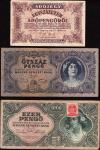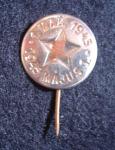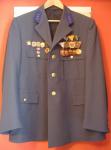-
Posts
2,660 -
Joined
-
Last visited
Content Type
Profiles
Forums
Blogs
Gallery
Events
Store
Everything posted by hunyadi
-
Another interesting find is the Provisoinal Government issuance of money to the Red Army in 1944. I am not certain if this was entirely meant for Soviet Soldiers or for the small contingent of Hungarian soldeirs who switched sides and joined with the Red Army to fight the Germans. The money is backed by the "Commander of the Red Army" as noted on the bills.
-
-
Unprecedented Hyperinflation With the formation of a new government underway the final days of 1945 slipped rapidly by as the citizens of Hungary eagerly awaited the arrival of 1946 and a new economical hope. During the short campaign period before the November election, the Hungarian economy was already in a massive downslide. The post war economy in Hungary was the world?s worst known case of hyperinflation. When the Hungarian currency known as the pengő was introduced in 1927 its largest denomination prior to the end of the war was the 1000 pengő bill. From its inception the pengő had remained relatively stable even during the war years. By December of 1945, however, the rising inflation had caused the pengő to be printed in denominations up to 10,000,000. Several factors caused such a rapid decline. Worldwide the economies of nearly every country took a natural downward turn after the end of the war. The victor?s economies naturally were far less in decline as speculation for the future was more positive. The future of a changing government, the ravages of war and its defeat along with the uncertainty of the middle and upper classes caused speculation and investment to all but vanish. Even if the middle and the upper classes had the confidence to invest, the sudden lack of their personal wealth presented another problem. The unprecedented quantity of valuables looted by the Russian Army forced the wealthy into near poverty. Even the financial institutions were not safe as Russian solders simply walked into the banks and took off with whatever they could carry. In once such instance, several Soviet officers entered the Hungarian General Credit Bank in Budapest January 20th, 1945. The manager was a helpless witness to the events as the officers forced their way into the vault and walked away with 113 million pengő, about 800 suitcases of valuables that had been left by clients for safekeeping as well as emptying over 1400 safety deposit boxes. In addition to the valuables and the money, the officers also took bank securities that were worth several million Pengő. None of it was ever returned or recovered. (Krisztian Ungvary Battle For Budapest 100 Days in World War II I.B. Tauris London ? New York 2003. (pg 280)) Speculation remains that such actions may have been an attempt by Moscow and Rakosi to destroy the upper classes of Hungarian society in order to more smoothly pave the way for the rise of a communist nation. Some confirmation of the theory can be gleaned from the formation of the Supreme Economic Council founded on November 24th, 1945. The Supreme Economic Council was formed by the decree of the Prime Minister to oversee and manage the postwar economy. Built within the framework of its scope was the ability to regulate production, distribution, import and export of materials. The council was also charged with distributing the wartime reparations to the Soviet Union, Yugoslavia and Czechoslovakia. The massive power of the economic council rested upon the shoulders of a close ally of R?kosi; Zolt?n Vas. Whether manipulated or uncontrolled, the effect was catastrophic to the nation. What little money the people of Hungary had after the war, they refused to inject it into the market except to buy the items essential for survival. Since basic goods were already scarce, prices began to rise rapidly. As these prices increased beyond what people had managed to hide away, the barter of hard goods became common practice for bread and sugar. In addition to the declining market, the salaries of the workers became nearly worthless as the wages of the workers could not be adjusted quickly enough. At the height of the hyperinflation period of 1946, the prices of goods were doubling every 15 hours. In response to the massive need to continually add zeros to the end of worthless banknotes the Hungarian tax authorities devised a system of the ad?pengő. The new ad?pengő was designed to pay for taxes as well as postage at the post office. It value was derived from the pengő beginning on January 1st 1946 where one pengő equaled one ad?pengő. The value remained fairly stable as by January 28th, 1946 it was exchanging one ad?pengő at 1.09 pengő. Conversely by July 28th, 1946 one ad?pengő was worth 2, trilliards pengő. Or a 2 with twentyone zeros after it... Top is an ad?pengő of the 100,000 denomination. In July of 1946 this would be worth a 2 with twentysix zeros after it. Second and Third are pengő from 1945
-

Soviet Medal for Valor - opinions please
hunyadi replied to hunyadi's topic in Russia: Soviet Orders, Medals & Decorations
Never researched before - never had a compelling reason to do so...untill now...so - here is what I can make out of the town: ORA [Z or a U] OBU -

Soviet Medal for Valor - opinions please
hunyadi replied to hunyadi's topic in Russia: Soviet Orders, Medals & Decorations
That is interesting - so now I need to be on the lookout for the other mismatched ribbon and medal. Sweet daughter, dumb engraver. As for the town - can you tell me which 'word' is the town and I could then try and decypher it as the scan is not the best. Many , many , many thanks guys! -

Soviet Medal for Valor - opinions please
hunyadi replied to hunyadi's topic in Russia: Soviet Orders, Medals & Decorations
-
Hi Snoopy - from my recolection this is the US Army Air Corps Patch that could be worn by anyone serive in the Army Air Corps. From the cut edge and the weave to the back, I would say this is WW2 vintage.
-

Hungary Hungarian Kivalo Dolgozol Badges
hunyadi replied to hunyadi's topic in Central & Eastern European States
Once again - many thanks! -

Hungary Hungarian Kivalo Dolgozol Badges
hunyadi replied to hunyadi's topic in Central & Eastern European States
Interestingly enoguh three of them have come up for sale. Some for an outlandish price and another one that would be comparable to a probe to Jupiter. I managed to find this one in the corner of an antique store and I also asked if he had any Partizan badges...'what are those?' was the reply... Zsolt - do you know anythign about these? -

Hungary Hungarian Kivalo Dolgozol Badges
hunyadi replied to hunyadi's topic in Central & Eastern European States
-

Bulgaria Bulgarian/Romanian? badges
hunyadi replied to Ed_Haynes's topic in Central & Eastern European States
Bulgarian -
Yes and the thugs of his vice president nearly killed my great-grandfather... but Happy Labor Day!
-

Hungary Box for hungarian order
hunyadi replied to Rodion's topic in Central & Eastern European States
Hi Rodion - The Socialist Hungary Order of Merit - A Szocialista Magyarorzagert Erdemrend is 45mm in diameter. Generally the recess for the medals have a good fit. 5mm is a bit loose for one of the higher state medals. Also the only examples that I have seen (one of them being atributed to Csanadi Arpad an Olympian medal winner - gold??) for the Socialist Hungary Order of Merit came in a white lined box with the wine red box cover. However - the fit of medals is not always perfect. In many of the lower medals the case was made to accept 38mm medals as a standard. Of course some were made smaller and some were made bigger - then at the factory they just stuffed them in, but this does not generally occur with the higher awards. -

Can anyone identify the branch of service ?
hunyadi replied to Hendrik's topic in United States of America
THe patch is the "Advance Section" Service of Supply. Or - forward Quartermaster. -
Happy Labor Day to all - here is a bit of history. Yes - they held a parade in Budapest ruins and all. Soldiers showed up in uniforms that were converted from several things. Wehrmacht belt buckles with the eagle shaved off or completely drilled out. Wehrmact caps with insignia removed. Peaked caps, service caps, etc..
-

Hungary Munkasor Dress Tunic
hunyadi replied to Gordon Craig's topic in Central & Eastern European States
Hey Dan - yes - its the sports badge, but this is an MHSZ badge - latter form. You have the MHS badge (same organization) which is much earlier. -

Hungarian sea scouts badge?
hunyadi replied to pluribus's topic in Central & Eastern European States
I see little pins like this but dont know the reason behind them - my "guess" is that this has somethign to do with law Top is Jog = 'Law' Left side says Igazsag = 'Truth' Right side says Szeretet = 'Love / Affection' So - 'Love of Law and Truth'? Magyarok.... segitseg!? -

Hungary Munkasor Dress Tunic
hunyadi replied to Gordon Craig's topic in Central & Eastern European States
Though I have been waiting to find an earlier type tunic from the late 1950's - early 1960's, I found this one at what I affectionatly refer to as 'The Thieves' market. (if your stero ends up missing on Friday - go on Saturday and you can buy it back...no questions asked...) Aside from the piles of junk "liberated" from trashcans, parked cars and appartments, there are some nice pieces of militaria to find in the haystack. I had to get this one because it speaks volumes about Munksor tradition...plus how could you miss out on all that 'bling'? This is a very nice and untouched Munkasor tunic from the 1980's. The cap (not shown) that came with it is marked for 1983 manufacture. Unfortunatly the dress tunics after 1956 were not marked for production date. But the tailors label inside the tunic is a dead give away for the final years of the Iron Curtain. One of the most interesting factors of the tunic (and why I bought it) was the way that the medal bar and the medals were sewn onto the tunic and have been there since the early / mid 1980's. My suspicions run that there was another medal next to the "Educators Service Medal" as there is some thread off the back of the ribbons that is cut. Perhaps some higher order was there and somone would pay more for just the medal? This tunic gives a great example to the fact that 'personal' taste rather than regulation dictated the medal placment. The 'dealer' told me that the tunic belonged to a professor of engineering. Which from all consideration that would be plausable. He has an Educators Medal, Plus the pins on the right side follow a form of an educator in engineering. Back to the medal bar - the Educators Medal, the Serivce to the Fahterland medals and the Serivce Medals - the last one being for 10 years of civil serivce to the Honved, are all out of whack! From peroid photos this is alos confirmed that it was up to the owner of the tunic to decide what medal went where. -
the stamps in post #16 and 17 are Russian stamps commonly found in tunics and items that they manufactured - not a 'film production' stamp. All in all - its a reenactors set that has been worn and beaten up - either from use or to deceive. As a piece of advice - the dealer who 'didnt want to reveal the name fo the vet' - didnt want anyone to do that becasue he kenw it was bad when he sold it... get your moeny back if you can.
-

EK 1914 Help to ID Crosses
hunyadi replied to flight1859's topic in Germany: All Eras: The Iron Cross
The date on the one shown is "1916". These were failry common 'patriotic' pieces for folks to wear to show support of the war, they had been in the war, something for the ladies to show thier byfriends / husbands were in the war, etc... These vary in size, design, shape. From the 'average' to the 'outlandish'. -

Hungarian sea scouts badge?
hunyadi replied to pluribus's topic in Central & Eastern European States
Not a common badge - or not one that I have seen before - but mind you most people are looking for Levente items. My best guess is that its for river work as the Danube Flotilla was a very nostalgic item during the period. But also anything to do with the river or the sea in Hungary is a rare item. AS for what is written on the back: CSERKESZBOLT = "Scouts Store" so I would guess that this was a shop where you could go and buy all the required scouting needs. NSANDOR U.6 = "Nagy Sandor" (Alexander the Great) Street #6










